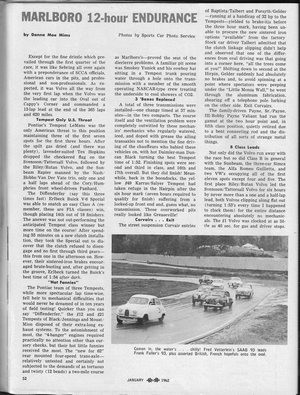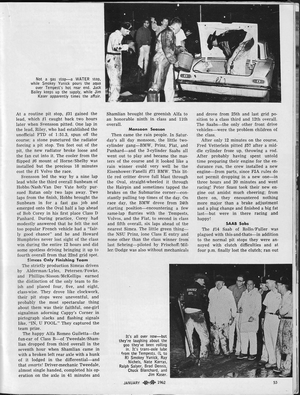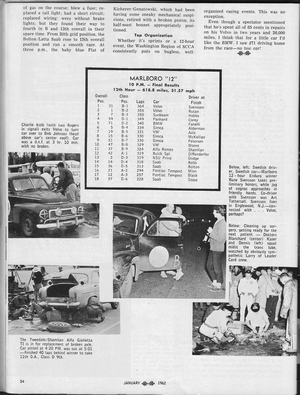|
By accessing/using The Crittenden Automotive Library/CarsAndRacingStuff.com, you signify your agreement with the Terms of Use on our Legal Information page. Our Privacy Policy is also available there. |

Marlboro 12-hour Endurance
|
|---|
|
|
Marlboro 12-hour Endurance
Donna Mae Mims
Today's Motor Sports, January 1962
Except for the fine drizzle which prevailed through the first quarter of the race, it was like Sebring all over again with a preponderance of SCCA officials, American cars in the pits, and professional and non-professionals. As expected, it was Volvo all the way from the very first lap when the Volvo was the leading car into the Oval out of Cappy's Corner and commanded a 13-lap lead at the end of the 365 laps and 620 miles.
Tempest Only U.S. Threat
Pontiac's Tempest LeMans was the only American threat to this position maintaining three of the first seven spots for the first three hours. After the spilt gas dried (and there was plenty), lavender-suited Tex Hopkins dropped the checkered flag on the Svensson/Tattersall Volvo, followed by the Riley/Rutan Volvo, and the Sunbeam Rapier manned by the Nash/Hobbs/Van Der Vate trio, only one and a half laps ahead of the Cory/Humphries front wheel-driven Panhard.
The Diffenderfer (say this three times fast) Erlbeck Buick V-6 Special was able to snatch an easy Class A (remember, these are FIA classes) win, though placing 14th out of 18 finishers. The answer was not out-performing the anticipated Tempest class winner but more time on the course! After spending 55 minutes on a new clutch installation, they took the Special out to discover that the clutch refused to disengage and no first through third gears—this from one in the afternoon on. However, their sintered-iron brakes encouraged brute-busting and, after getting in the groove, Erlbeck turned the Buick's best time of 1:54
after dark.
"Hot Fannies"
The Pontiac team of three Tempests, while more spectacular lap time-wise, fell heir to mechanical difficulties that would never be dreamed of in ten years of field testing! Quicker than you can say "Diffenderfer," the #12 and #21 Tempests of Black/Jennings and Mouat/Mion disposed of their extra-long exhaust systems. To the astonishment of most, the "4-banger" engines required practically no attention other than cursory checks, but their hot little fannies received the most. The "new for 62" rear mounted four speed trans-axle—relatively untested and certainly not subjected to the demands of as tortuous and twisty (12 bends) a two-mile course as Marlboro's—proved the seat of the dierrierre problems. A familiar pit scene was Smokey Yunick and his cowboy hat sitting in a Tempest trunk pouring water through a hole onto the transmission with a member of the smooth operating NASCAR-type crew treating the underside to cool showers of CO2.
3 'Boxes Replaced
A total of three transmissions were installed—one change timed at 37 minutes—in the two compacts. The course itself and the ventilation problem were completely outwitted by these mechanics' mechanics who regularly watered, iced, and doped with grease the ailing transaxles not to mention the fine driving of the chauffeurs who babied these vehicles on, with hot Daimler-man Duncan Black turning the best Tempest time of 1:52. Finishing spots were second and third in class, and 16th and 17th overall. But they
did finish! Meanwhile, back in the boondocks, the yellow #49 Karras/Salyer Tempest had taken refuge in the Hairpin after the six hour mark (seven hours required to qualify for finish) suffering from a locked-up front end and, guess what, no transmission. Those overworked pits really looked like Greaseville!
Corvairs . . . Exit
The street suspension Corvair entries of Baptista/Talbert and Forsyth/Gelder—running at a handicap of 32hp to the Tempests—yielded to brake-itis before the three hour mark, having been unable to procure the new sintered iron options "available" from the factory. Stock car driver Talbert admitted that the clutch linkage slipping didn't help and observed that one of the differences from oval driving was that going into a corner here, "all the trees come at you!" Shifting down to second at the Hirpin, Gelder suddenly had absolutely no brakes and, to avoid spinning at a point where spectators were peeping under the "Little Monza Wall," he went through the aluminum fabrication, shearing off a telephone pole lurking on the other side. Exit Corvairs.
The family-driven Payne, Sr./Payne, III/Bobby Payne Valiant had run the gamut at the two hour point and, in fifth class position, quietly retired due to a bent connecting rod and the distribution of all sorts of strange metal things.
B Class Leads
Not only did the Volvo run away with the race but so did Class B in general with the Sunbeam, the three-car Simca team, the Alfa Romeo Guilietta, and two VW's occupying all of the first eleven spots except four and five. The first place Riley/Rutan Volvo led the Svensson/Tattersall Volvo for six hours by never more than a one and a half-lap lead, both Volvos clipping along flat out (turning 1:53's every time I happened to clock them) for the entire distance encountering absolutely no mechanicals. The #1 Volvo was clock at as little as 40 sec. for gas and driver stops. At a routine pit stop, #31 gained the lead, which #1 caught back two hours later when Svensson pitted. One lap in the lead, Riley, who had established the unofficial FTD of 1:51.3, spun off the course; a stone punctured the radiator forcing a pit stop. Ten feet out of the pit, the new radiator broke loose and the fan cut into it. The cooler from the flipped #6 mount of Horne/Shelby was installed but the precious 18 minutes cost the #1 Volvo the race.
Svensson led the way by a nine lap lead while the third overall Sunbeam of Hobbs/Nash/Van Der Vate hotly pursued Rutan only two laps away. Two laps from the finish, Hobbs brought the Sunbeam in for a fast gas job and emerged onto the Oval half a lap ahead of Bob Corey in his first place Class D Panhard. During practice, Corey had modestly answered that he felt the not too popular French vehicle had a "fairly good chance" and he and Howard Humphries never lost never lost sight of the class win during the entire 12 hours and did some spotless driving bringing it up to fourth overall from that 22nd grid spot.
Simcas Only Finishing Team
The strictly production Simcas driven by Alderman/Lyles, Petersen/Fowke, and Phillips/Sisson/McKellips earned the distinction of the only team to finish and placed four, five, and eight, class-wise. They drove like clockwork, their pit stops were uneventful, and probably the most spectacular thing about them was their faithful, one-girl signalman adorning Cappy's Corner in pictograph slacks and flashing signals like, "IN, U FOOL." They captured the team prize.
The happy Alfa Romeo Guiletta—the fun-car of Class B—of Tweedale/Shamlian dropped from third overall in the seventh hour when Shamlian came in with a broken left rear axle with a hunk of it lodged in the differential—and that
smarts! Driver-mechanic Tweedale, almost single-handed, completed his operation on the axle in 41 minutes and Shamlian brought the greenish Alfa to an honorable ninth in class and 11th overall.
Monsoon Season
Then came the rain people. In Saturday's all-day monsoon, the little two-cylinder gang—BMW, Prinz, Fiat, and Panhard—and the 3-cylinder Saabs all went out to play and became the masters of the course and it looked like a rain winner could very well be the Eisenhower/Fanelli #71 BMW. This little red critter drove full blast through the Oval, straight-wheeled it through the Hairpin and sometimes tapped the brakes on the Submarine corner—constantly pulling top times of the day. On race day, the BMW drove from 24th starting position—encountering a few same-lap flurries with the Tempests, Volvos, and the Fiat, to second in class and fifth overall, six laps ahead of the nearest Simca. The little green thing–the NSU Prinz, lone Class E entry and none other than the class winner from last Sebring—piloted by Frischoff/Miller/Dodge was also without mechanicals and drove from 25th and last grid position to a class third and 12th overall. The Saabs—the only other front drive vehicles—were the problem children of the class.
After only 12 minutes on the course, Fred Vetterlein pitted #57 after a middle cylinder froze up, throwing a rod. After probably having spent untold time preparing their engine for the endurance run, the crew installed a new engine—from parts, since FIA rules do not permit dropping in a new one—in three hours and 20 minutes and went racing! Peter Szasz took their new engine out amidst much cheering; from there on, they encountered nothing more major than a brake adjustment and a plug change and finished a big fat last—but were in there racing and happy!
SAAB Sobs
The #14 Saab of Rollo/Fuller was plagued with this-and-thats—in addition to the normal pit stops they were annoyed with clutch difficulties and at four p.m. finally lost the clutch; ran out of gas on the course; blew a fuse; replaced a tail light; had a short circuit; replaced wiring; were without brake lights; but they found their way to fourth in B and 13th overall in their spare time. From 20th grid position, the Bolton/Latta Saab rose to 15th overall position and ran a smooth race. At three p.m., the baby blue Fiat of Kicherer/Genatowski, which had been having some sneaky mechanical suspicions, retired with a broken piston, its half-mast bonnet appropriately positioned.
Top Organization
Whether it's sprints or a 12-hour event, the Washington Region of SCCA consistently puts on bugless, well-organized racing events. This was no exception.
Even though a spectator mentioned that he's spent all of 85 cents in repairs on his Volvo in two years and 26,000 miles, I think that for a little car I'd like the BMW. I saw #71 driving home from the race—
no tow car!





















